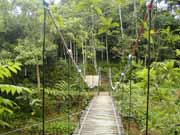 |
|
Flying Vines |
| |
 |
|
A Suspension Bridge in the Scenery Spot |
The Rain Forest Zone situates in the rain forest valley in the eastern part of the Tropical Botanical Garden; it is an important research and tourist spot of the botanical garden, and at the same time, the largest, the most diversified and the most characterized preservation area of rare plants and
endangered plants in China at present. The workers here mainly collect, study and protect rare wild plants and
endangered plants in South Yunnan; in the meanwhile, this scenery spot also serves purposes such as tourism in the rain forest and promotion of
public understanding of sciences.
The Rain Forest Spot occupies an area of 1200 mu and consists of a piece of upland and small hills. This part has an elevation of 540-730 meters, it is full of valleys and gouges, and the biotope is particularly complicated here. The original vegetation of this part was monsoon forest, which was destroyed afterwards. The Rain Forest
Zone was established in 1983, from 1985, it began to transplant
endangered plants and to carry out monitoring on biological diversity in the tropical rain forests. During the 15 years, this spot altogether transplanted more than 400
endangered plants in South Yunnan, and 56 key protection plants of China; for the time being, it has altogether 2000 varieties of native plants, which accounts for 50% of the plant system of Xishuangbanna. All the transplanted plants grow very well in the spot, some have begun to abloom, fructify and produce offspring.
The Rain Forest Zone pot demonstrates the biological diversities of plants, the evolving changes of the forest groups, the mighty scenes of rain forest, the reaction of plants to natural history, the use of plants, the competition of species, the threat and protection over plants etc.
 |
 |
|
Neottopteris nidus |
Wild Yam |
 |
 |
|
Rain Forest in Valleys |
The Ecological Watching Tower
in the Rain Forest |

|

